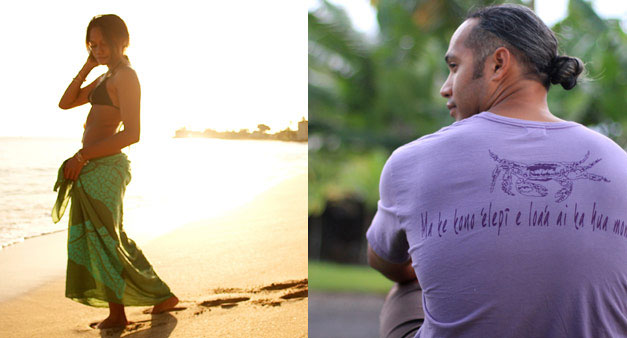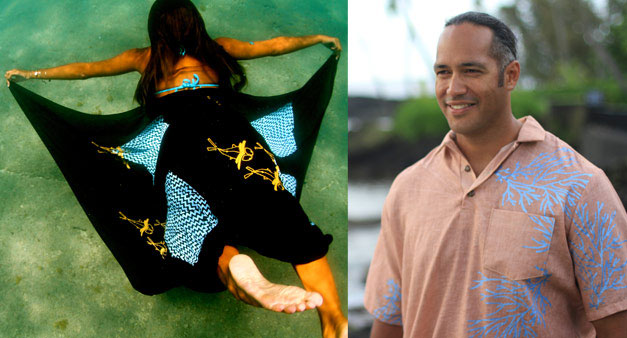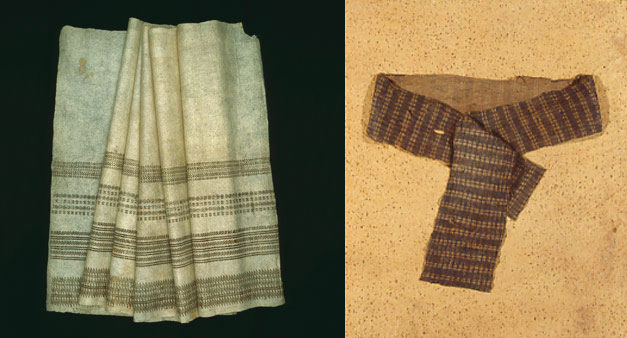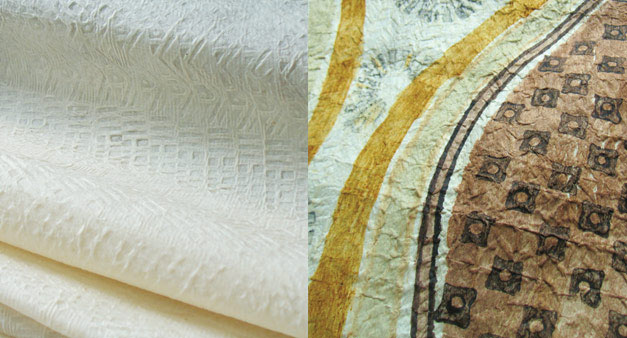Story by Teri Freitas Gorman | Photos courtesy of Kealopiko, Dalani Tanahy, David Young
 The brown-skinned beauties who for generations adorned book jackets and sheet-music covers, movie posters and travel ads, may have conveyed the romance of tropical islands, but their clingy sarongs and swishy grass skirts didn’t mirror reality.
The brown-skinned beauties who for generations adorned book jackets and sheet-music covers, movie posters and travel ads, may have conveyed the romance of tropical islands, but their clingy sarongs and swishy grass skirts didn’t mirror reality.
What did real-life islanders wear before western missionaries introduced the all-concealing muumuu?
Hawaii’s benign climate called for fashion of simple construction and suitably cool material. Early Hawaiians, from makaainana (commoners) to alii (royalty), wore everyday clothing mostly fabricated from kapa, whose name, “the beaten thing,” refers to its laborious preparation. Kapa makers stripped the bark of the wauke (mulberry) plant, soaked and fermented it, then rhythmically beat it into a fine and surprisingly soft cloth.
 According to Hawaiian cultural practitioner Kahu Lyons Naone, the basic dress for mature males was a malo (loin cloth), and adult females wore a pau (skirt). Neither sex covered their upper bodies with clothing. Young children went nude; boys were given their first malo when their urine stream began to arc, signaling the time to move into the hale mua (men’s house). In cooler elevations and seasons, a kihei, a cape made of kapa, provided added warmth. A kui lai, or rain cape made from interwoven ti leaves, gave protection during hooilo, the wet season.
According to Hawaiian cultural practitioner Kahu Lyons Naone, the basic dress for mature males was a malo (loin cloth), and adult females wore a pau (skirt). Neither sex covered their upper bodies with clothing. Young children went nude; boys were given their first malo when their urine stream began to arc, signaling the time to move into the hale mua (men’s house). In cooler elevations and seasons, a kihei, a cape made of kapa, provided added warmth. A kui lai, or rain cape made from interwoven ti leaves, gave protection during hooilo, the wet season.
Oahu kapa practitioner Dalani Tanahy has devoted much of her life to studying Pacific traditions of bark-cloth fabrication. She has examined international collections and spent countless hours researching the extensive kapa collection in the Bishop Museum’s back rooms to understand the artistry and cultural history specific to Hawaiian kapa.
“One of my responsibilities as a kapa maker is to be sure that whatever I say can be attributed to a respected teacher, kupuna [elders], my personal experience; or corroborated by credible research,” says Tanahy. “I don’t believe in romanticizing history. Based on what I have learned, pre-Contact Hawaiian kapa was primarily functional. If you were makaainana, your clothing was plain, with few, if any, decorative designs, because it had to be practical, washable, durable.
 “Kapa belonging to alii was much more colorful and decorative. It was presented as gifts and offerings, so extra effort went into making this kapa especially beautiful.” Among the peoples of Polynesia, only Hawaiians employed a rainbow palette of natural dyes and inks to color their kapa. Did those different colors help identify clans, vocations, or class?
“Kapa belonging to alii was much more colorful and decorative. It was presented as gifts and offerings, so extra effort went into making this kapa especially beautiful.” Among the peoples of Polynesia, only Hawaiians employed a rainbow palette of natural dyes and inks to color their kapa. Did those different colors help identify clans, vocations, or class?
“Except for the ruling class,” says Tanahy, “it’s more likely the use of specific colors [reflected] the resources readily available in a specific ahupuaa [land division]. This would explain why family members often wore the same color, but there is no evidence this was a cultural practice.”
According to Tanahy, most pre-Contact kapa that did have decoration displayed large, bold designs.
“We don’t see the intricate, complicated ohe kapala [bamboo stamp] designs and textured watermarks imbedded into kapa until after Cook’s arrival. When Hawaiians saw the patterned fabrics brought in by the missionaries, they tried to replicate them in kapa. They were great adopters and adaptors of outside influences and tools.”
The women behind the clothing company Kealopiko carry on that Hawaiian tradition of adoption and adaptation in contemporary, cultural designs. Established in 2006, Kealopiko is the brainchild of three young hapa [part-Hawaiian] wahine: Jamie Makasobe, Hina Kneubuhl and Ane Bakutis.

“Clothing is an expression of who you are and what you believe in,” says Makasobe. “There is a much greater awareness of what is truly Hawaiian these days and we saw clothing as way to express our culture in a positive, authentic way. We also saw it as a chance to enlighten and educate.”
The partners have built the quintessential twenty-first-century business by harnessing the power of technology to operate, in Makasobe’s words, “a multi-moku [interisland] company that allows us to work remotely from Oahu, Molokai, Maui, or wherever one of us is on any given day.”
Oahu-based Makasobe is responsible for graphic design, sales and marketing, and the company website. Bakutis, a Waianae girl now living on Molokai, is the seamstress and fashion designer. Kneubuhl, a former UH-Manoa Hawaiian-language teacher from Maui, is the manao (meaning) maker. She researches and writes the cultural descriptions behind each of their designs.
You don’t achieve authenticity in Hawaiian practices without immersing yourself in nature. Bakutis and Kneubuhl both have extensive training in ethnobotany, and Makasobe spent years restoring and caring for a traditional Hawaiian fishpond in Kaneohe. The three share an enduring interest in, and love for, all things Hawaiian.
Makasobe says their original plan was to create a clothing line that would appeal to a new generation of young Hawaiians. Their customers had other ideas. “They turned out to be aunties, uncles, kupuna, conservationists, tourists, botanists, cultural practitioners and people living on the mainland—a real crazy mix of ages and lifestyles.”
Kealopiko’s contemporary, graphic clothing designs depict Hawaii’s natural, cultural, and historical stories in a way that challenges the wearer to rethink the past to better understand the present.
The company’s values and practices are rooted in Hawaiian traditions. For example, Kealopiko releases new lines during the seasons of Ku (just before Easter), and Makahiki (around Thanksgiving). The Makahiki designs aptly reflect nature and the abundance of harvest time, while the Ku line features more historical, cultural, and political themes.
Faithful to the Hawaiian value of aloha aina (love of the land), their socially responsible clothing is made with earth-friendly manufacturing practices. “We use water-soluble dyes and inks,” says Bakutis, “and 80 percent of our clothes are made from organic cotton or bamboo.”
Whether depicting a historical figure, a native plant or animal, or a Hawaiian artifact, each Kealopiko design carries a moolelo—a story or narrative—told through a trademark yellow tag that accompanies the clothing and contains rare nuggets of cultural history and wisdom.
“We consider many factors before we select our designs,” says Bakutis. “What is the relationship of the design to place? Will the design teach something important? What are its other, lesser-known meanings?”
While pre-literate Hawaiians couldn’t have incorporated written language into clothing, Kealopiko designs do.
“We like to use older, uncommon Hawaiian vocabulary and grammar like what we hear in historic recordings or read in ka nupepa, the old Hawaiian-language newspapers,” says Bakutis. “We think it’s important to revive the language, to keep it alive and vibrant.”
Hawaiian is a highly metaphorical language that can communicate several ideas at multiple levels simultaneously. While what is said makes perfect sense at the literal level, there are often veiled tiers of allegory and wordplay that tell completely different and unrelated stories. This is why it frequently takes so many English words to translate one in Hawaiian.
Some students of kapa theorize that ancient Hawaiians concealed kaona (hidden meanings) in their clothing—though Tanahy says she’s found nothing in her research to substantiate that idea, and suspects that if any pre-Contact clothing really were imprinted with designs of significant and secret meaning, it would have been preserved even after the missionaries arrived. On the other hand, ceremonial garb worn by alii, typically made from colorful feathers, was meant to symbolize their wearers’ origin in the higher realms.
What about the kaona of watermarks and overlaid print designs?
“Some are obvious interpretations of things that Hawaiians saw in everyday life,” says Tanahy, “such as feathers, fish bones, shark teeth. . . . There are deeper interpretations of some of these symbols, but much of that information has been lost to us. Did these markings mean something profound? Maybe. But I believe many of the designs were created purely for aesthetic pleasure.”
Many generations later, the women of Kealopiko continue to create for aesthetic pleasure, but their modern designs carry out their not-so-covert mission to teach today’s makaainana about a history customarily told by colonizers, the resilient strength of a culture that went underground to endure, and a fragile ecosystem struggling to survive the assault of modern life.
“It is amazing, really inspirational to see how creative our kupuna were,” says Bakutis. “The excitement of creating our own designs comes from learning from our kupuna. As contemporary Hawaiian clothing designers, we think about our kupuna constantly. We hope they are proud of us.”
Kapa Hawaii
www.kapahawaii.com
Kealopiko
P.O. Box 698
Kaunakakai, HI 96748
Ph: 808.216.9229 | 808.393.8280






Beautiful!
Mahalo for the research and sharing the knowledge.